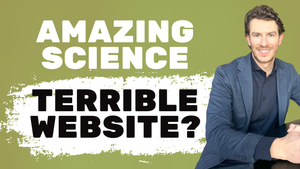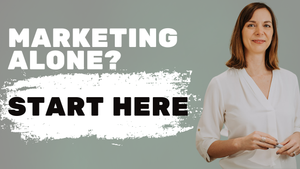🎧 Listen to this episode:
🔔 Subscribe to the podcast
🎥 Watch it on YouTube
📖 Or read the summary of the interview:
When a potential investor, partner, or scientist visits your company online, your website is often their first impression. In the life sciences—where trust, credibility, and clarity matter above all else—that first impression can define whether someone chooses to engage further or move on.
That’s the starting point for my conversation with Maurice van Rotterdam, co-founder of Sciential, a digital marketing agency based in the Netherlands that specializes in life-science and health-sector clients.
In this interview, Maurice shares his playbook for creating websites that not only look good but also work strategically for business growth and he explains why the next wave of innovation, powered by AI, is already reshaping how life-science companies should think about digital presence.
What makes life sciences websites unique
Maurice didn’t start his career in marketing. “I studied biomedical sciences at the University of Leiden and specialized in tumor immunology,” he recalled. After a period in consulting, he discovered his passion lay in translating complex science into language and visuals that others could understand. “Two things keep me running,” he said, “translating difficult technical information into easy, understandable information and activating people.”
Together with two co-founders, he launched Sciential five years ago. The agency now employs around 30 people, serving clients across Europe, the U.S., and Asia. “Most of our clients are service providers in the pharma outsourcing niche—CROs and CDMOs—but we also work with biotech innovators and startups.”
As Maurice explained, life-science websites face challenges other industries rarely encounter. “If you compare it to fast retail goods, it’s completely different,” Maurice said, “you have multiple types of audiences visiting the website—scientists, CEOs, investors—and each one needs a specific kind of information at different stages of the buyer journey.”
That complexity makes it difficult to balance depth and simplicity. “You don’t want 100 pages that nobody actually visits,” he said. “It’s about being precise and targeted.”
The global nature of the industry adds another layer of difficulty. “US website visitors behave slightly differently from European ones,” he noted. “So UX design has to account for those differences too.”
And while these challenges may seem technical, the biggest obstacles are often strategic, starting with how companies perceive their websites in the first place.
Maurice sees one recurring issue across the industry: undervaluing the website itself.
“From our perspective, the website is the nucleus of the whole marketing strategy,” he said. “Whether you run a campaign on Google or LinkedIn or attend an event, everything comes back to the website. Yet many companies still treat it like something built in 1990 that just needs to exist.”
Beyond that, he sees three major design and strategy pitfalls:
- Ignoring the audience: “Companies often design from their own perspective,” Maurice explained. “They’re experts in their services, but don’t dive into who’s visiting. Is it a scientist, a CEO, or a private-equity firm? That changes everything.”
- Poor UX design: “Many sites require seven clicks to reach the important information,” he said. “If it’s more than three clicks away, people won’t get there.”
- Information overload: “Infinite-scroll pages full of jargon don’t work, and they don’t help SEO either,” he warned.
Recognizing these mistakes is the first step, but knowing how to fix them requires a structured process, something Maurice and his team have perfected over time.
Where every project starts
When a client approaches Sciential for a website revamp, Maurice starts with discovery. “I first want to understand their business case: what they sell, to whom, and who their competitors are,” he said.
Once that’s clear, his team performs a detailed audit. “We use analytics, Hotjar, and Microsoft Clarity to see which pages are viewed, where people bounce, and how they convert,” he explained. “Sometimes clients think certain pages are most important, but the data shows nobody visits them.”
From that analysis, Sciential creates a recommendation report that outlines a new structure and priorities. “It’s only after we fully understand the current website that we start designing the next one.”
One of the hardest parts of life-science web design is serving multiple personas—scientists, executives, and investors—without overwhelming anyone.
Maurice’s solution: tailor the experience from the start. “I’m a big fan of adding a sub-header above the main navigation saying ‘Researcher,’ ‘Investor,’ or ‘C-Level Executive,’ so each group can click through to a version of the site designed for them,” he said.
Simple menu structures and segmented homepage sections also help guide visitors to what matters most for them.
And while structure determines how people move through a website, the next challenge lies in what they actually read once they’re there.
“Most biotech companies want to pitch their technology,” Maurice said. “But I still advise keeping it super simple on the website and having a separate portal where people with access can read more.”
That approach serves both sides: public pages stay clear and engaging, while serious prospects—investors, partners, or grant agencies—can dig deeper after reaching out. “For 90 percent of biotech companies, I would delete half their pages,” he said bluntly.
For CROs and CDMOs, however, he prefers open content: “I’m a big fan of non-gated information. You want people to explore your services freely.”
Of course, the content is only half the story; the design itself must communicate credibility and personality at first glance.
Asked how to balance aesthetics with professionalism, Maurice smiled. “It’s a thin line,” he said. “Our industry is conservative, and that’s okay. You don’t want flashy, animated websites that feel like a tech startup. You want something clean, credible, and sharp.”
That doesn’t mean boring. “You need to stand out. Stop using stock images. Invest in professional photos and short videos that show your team and facilities,” he urged. “People choose partners based on trust and personal connection. Giving your company a face matters.”
He also encourages updating visual identities every few years. “Usually after four or five years, your brand needs a sparkle again, small tweaks like new gradients or animations to stay current without changing your whole logo.”
And when those design principles are applied correctly, the results speak for themselves.
When good UX pays off
Maurice shared two favorite case studies that show measurable results.
The first was 3DHISTECH, a Hungarian company supplying histology equipment and software. “Their old website was from the early 2000s,” he said. “We rebuilt it with better UX and A/B tests on landing pages, focusing on lowering barriers to contact. We added calendar invites to schedule calls directly with experts. Within six months, they had four times more incoming conversations.”
The second was Insphero, a Swiss company known for its organ-on-a-chip technology. “We combined a rebrand with a new website focused on SEO,” Maurice explained. “Their visibility for core keywords increased by more than 50 percent, and loading speed improved dramatically.”
These examples show that strong design isn’t just about aesthetics, but also performance and growth. Yet even the most beautiful design fails if the technical setup is poor.
On this front, Maurice recommends simplicity and flexibility. “We’re big fans of WordPress with Elementor because it’s user-friendly,” he said. “After launch, clients should be able to create new events or blog pages themselves. If you need your agency for every edit, that’s not a good sign.”
He also stresses mobile friendliness, fast loading speed, and avoiding plugin bloat. “Everyone keeps adding plugins, and it slows everything down,” he said. Hosting is another overlooked factor: “If your server’s in Europe but your clients are in the U.S., your site will load slowly there.”
But even with the right tools and structure, not every company needs to go big from the start.
What about companies with limited budgets? Maurice’s advice is clear: start small and simple.
“If you’re a biotech startup with ten people, one page is enough,” he said. “Show your technology, your team, and a way to get in touch. Don’t burn resources on a big site.”
And as new technologies emerge, even simple websites can evolve quickly, especially with the rise of AI.
How AI is transforming the web
Looking ahead, Maurice believes artificial intelligence will fundamentally change how websites function. “With all the developments in AI, this will really disrupt how we look at websites,” he predicted.
He imagines sites that act as intelligent assistants: “You could have a menu where visitors ask questions to an AI agent that answers based on your database. It makes the experience more tailored.”
For early adopters, the opportunity is now. “If you’re a CDMO or CRO, this is the moment to jump on the train,” Maurice advised. “Being the first to implement an AI chat on your site can make you a front-runner.”
He’s already seeing differences in user behavior: “People coming from large-language-model search spend more time on websites than those coming from Google. That shows how our buying process in pharma outsourcing will change. It’s all based on trust, and the website will become even more central to building that trust.”
After decades of slow digital progress, life-sciences websites have finally caught up, and, in some cases, are setting the pace.
As Maurice summed up: “It’s becoming much more modern and pleasing to the eye. The companies that invest now—especially those embracing AI—will lead the next generation of trust-driven, high-performing life-sciences brands online.”





